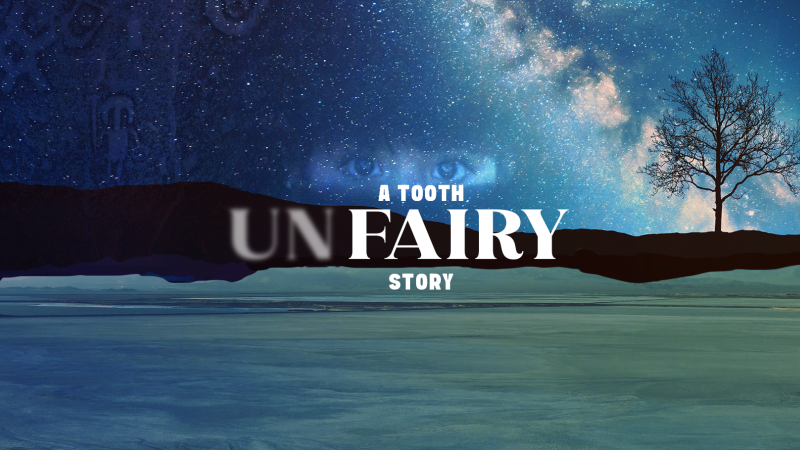A Tooth Unfairy Story

Tree rings are like markers that help us see how the climate and environment have changed over time. Trees can serve as a repository of pollution, storing various pollutants, including toxic metals that can affect human health, within their annual growth rings. This provides environmental records that go beyond the time covered by instruments or in places where such data is not accessible.
Sixty years ago, the Chilean government introduced Cupressus macrocarpa, a common pine from North America, as an ornamental plant in some areas of the Atacama Desert, which is known for having the highest radiation level on the planet.
This tree has been widely employed for dendrochemical analysis, which involves studying the variation of chemical elements over the years by measuring the rings of a tree.
Cupressus macrocarpa was the starting point of this film.
About ten years ago, Nicolás Zanetta (37) started his career as a researcher. He decided to focus his work on the Atacama Desert, and the difficulties that could be arising from the increased mining activity over the territory at the beginning of the nineties.
After a long time and extensive analysis of soil, water and Cupressus tree rings that were planted along the watershed that hosts one of the world's largest copper mines, Chuquicamata, the conclusions were evident: a large amount of heavy metals not from nature have been lodged all over Atacama´s soil.
Cupressus are Like humans. Exposed to this pollution, both will soon excrete arsenic. Its illness will be seen first in a decline, then in death. In people who have been exposed to arsenic, we can see that the disease manifests itself in the long term, after 40 years, it can develop cancer.
Our project is a 60-minute long documentary about those few human beings who dare to set up a life in the desert and cope not only with the scarcity of water and the absence of vegetation, but also with an acidic soil that was once fertile and today is a danger to their existence. Still, for these people, life can be enjoyable.
The research previously done by Nicolás through the tree rings is the initial device to tell the story of Caroline (43), an Atacama native mother who tries to live with her three children Andrés (14), Abdalai (6) and Adele (2) a much better life, far from the pollution of the mine and its bad habits, as Calama, the capital of the province of Atacama where the big mining companies are located, is known among Chileans as the city of dust, alcohol and prostitution.
Two years ago, this young poet and dressmaker decided to move to a land owned by the Chilean state and its mining company CODELCO. There, she set up her ranch, her chickens and raised and planted 20 Cupressus trees, protected by truck tyres, which she dreams will grow to provide shade for her descendants. The ground where Caroline lives is dry on the surface, but deep in the rock hides the beta through which the mine will expand sooner rather than later. Eviction is imminent.
Caroline not only struggles with this uncertainty, but also with a rare urachal cancer that has appeared a few months ago in her body and is in partial remission.
Will Caroline be able to live the dream of a better life in the desert with her family? Where will Chile's large-scale copper mining and its contribution to clean energy go, without recognising and preventing the lethal marks it leaves behind?
The answers could lie in the next steps of Nicolás' research on baby teeth samples taken from the Atacama children, which we intend to follow up during this film in laboratories in Boston and Germany. In the baby teeth, as in the tree rings of the Cupressus macrocarpa, calcium and potentially toxic elements such as arsenic and mercury are stored from the first embryonic moment. The results of this research are not only intended to be published in an academic paper, but also to be shown and explained during the shooting of this film to the inhabitants of Atacama, including Caroline and her family.
About Beatriz and Nicolás research:
Beatriz is interested in delving into the timeline that begins in the early twentieth century in Chile, where mining is installed as a cultural factor and at the same time, and silently, as main source of environmental damage with the alienation of rivers and later with the construction of huge tailings that modified earth's geology, under which lives a large part of the country's population.
With a focus on the energy transition era, Nicolás's research delves into the temporal and spatial impact of mining activity. Drawing on diverse environmental matrices, including sediment dust, surface soil, and tree rings, Zanetta-Colombo aims to unravel the multidimensional environmental consequences of mining. His work sheds light on the often-underestimated risks faced by indigenous communities residing in the Atacama Desert, a region historically affected by the mining industry. Through his research, Zanetta-Colombo uncovers evidence of negligence at the local scale, bringing attention to the detrimental effects on both the environment and the well-being of communities. By examining various environmental indicators, his research aimed to contribute to a comprehensive understanding of the mining industry's ecological footprint in northern Chile.

